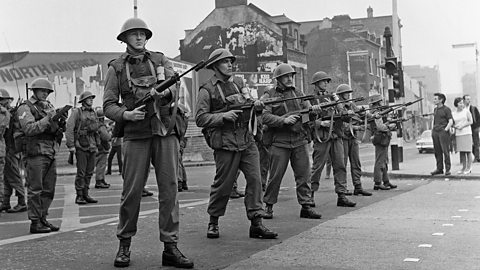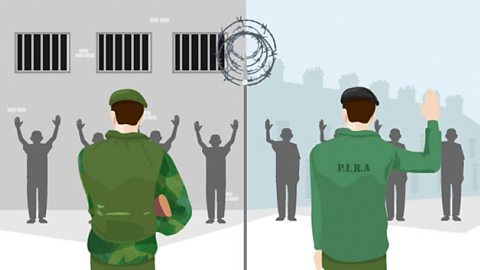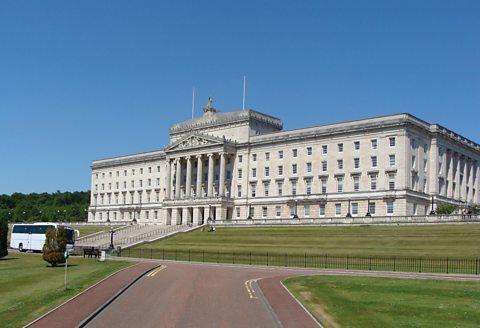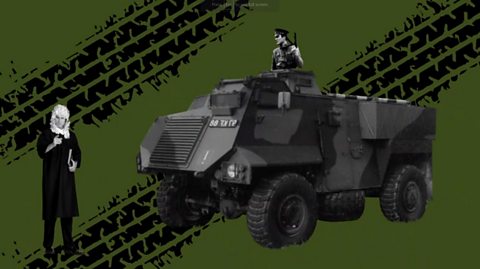Rioting
Following events at Burntollet and Derry/Londonderry, Northern Ireland Civil Rights Association (NICRA) marches and the resulting counter-demonstrations became even more confrontational.
Tensions in Belfast rose to the extent that serious rioting broke out in the summer of 1969.
Increasing tensions
As time moved closer to Northern Irelandâs traditional marching season (July-August), there were increasing concerns about what would happen.
- The Government in London was so worried about the deteriorating situation in Northern Ireland that it had set up a special cabinetThe name given to the core group of politicians who carry out the major roles within the ruling government of a country. Committee on Northern Ireland.
- The Dublin administration sent an intelligence officer to Northern Ireland to report what was happening to the minority nationalistPeople who believe their country should be independent from other nations. For example, Irish nationalists, who want Ireland to be fully independent of Britain. community.
- The Stormont Government feared that any more increases in the levels of unrest/violence would overwhelm the police.
Furthermore, there was growing evidence that paramilitary groups were emerging within both communities:
- loyalistA person who, in terms of culture, identity and politics, retains a strong loyalty to Britain and firmly opposes a united Ireland. paramilitaryA person or organisation that operates like a military force, but is not part of a country's official armed forces. were being set up to stop nationalists gaining further concessions.
- Irish republicanA person who wants to establish an all Ireland republic completely independent of Britain. paramilitaries were being set up to protect their own community.
The summer of 1969
Violence in Derry/Londonderry in 1969
The unrest that had been feared made its appearance in July 1969.
Trouble first occurred in Belfast, but the worst unrest broke out in Derry/Londonderry in the aftermath of the Apprentice BoysA loyalist historical club set up to remember the group of apprentices who closed the gates of Derry/Londonderry against the armies of King James II in 1689. marches in August.
The rioting that took place in Derry/Londonderry lasted for 50 hours and was given the name 'the Battle of the Bogsideâ.
In the end, the police were so exhausted that the decision was taken to order a small number of British troops on to the streets to help restore calm.
The troops arrived on the 14th August 1969.
However, violence continued elsewhere, especially in Belfast.
Violence in Belfast in 1969
Bad as things were, they were not helped by the decision of TaoiseachThe prime minister of the Republic of Ireland (formerly Ăire). The word is Irish for chieftain. Jack Lynch to issue a statement on events north of the border.
Lynch stated that:
It is evident that the Stormont Government is no longer in control of the situation. Indeed the present situation is the inevitable outcome of the policies pursued for decades by successive Stormont Governments. It is clear, also, that the Irish Government can no longer stand by and see innocent people injured and perhaps worse.
Whatever his intention, Lynchâs words - and his decision to send both Irish soldiers and field hospitalA mobile medical unit. to locations close to the border â did not help an already tense situation.
The events of August 1969 were later to be seen as a turning point in the development of what became known as the âTroublesâ.
They were seen as directly responsible for:
- The deployment of the British Army on the streets of Northern Ireland in an attempt to restore law and order.
- The eventual re-emergence of the Irish Republican Army (IRA)A republican paramilitary group which was determined to create an Irish Republic as proclaimed in the 1916 Easter Rising..

The Downing Street Declaration (August 1969)
The Government in London also decided that it was time to get involved.
Following a two-day meeting between British Prime Minister Harold Wilson and Northern Ireland Prime Minister James Chichester Clark on 19th August, a statement was issued that sought to provide reassurance to both nationalistPeople who believe their country should be independent from other nations. For example, Irish nationalists, who want Ireland to be fully independent of Britain. and unionistA person who believes the union between Britain and Northern Ireland should continue. in Northern Ireland.
The statement â known as the Downing Street Declaration (1969) â stated that:
- Northern Ireland should not cease to be a part of the United Kingdom without the consentApproval or agreement, particularly after thoughtful consideration. of the people of Northern Ireland. This was designed to appeal to unionists.
- Every citizen of Northern Ireland is entitled to the same equality of treatment and freedom from discriminationTreating people differently on the basis of a particular characteristic, such as race, religion or sex. as exists in the rest of the United Kingdom irrespective of political views or religion. This was designed to appeal to nationalists.
More reforms
In the days and weeks that followed, a number of other reforms were announced.
These included:
- The introduction of one man one vote for local elections.
- An end to gerrymanderingThe practice of drawing electoral boundaries in a way that benefits one particular group at the expense of another..
- The establishment of a committee to investigate policing in Northern Ireland (this committee was chaired by Lord Hunt).
- The creation of a tribunalA body set up to reach a decision on a particular issue. led by Lord Scarman to investigate recent disturbances in Northern Ireland.
- The setting up of a new housing authority to look after the housing functions previously undertaken by local councils.
- The implementation of a range of measures aimed at preventing discriminationTreating people differently on the basis of a particular characteristic, such as race, religion or sex. in public employment.
In addition, it was announced that there would be a new Ministry of Community Relations.
Alongside these reforms a number of actions designed to improve Northern Irelandâs economy were also revealed.
These included:
- Additional investmentMoney or capital put into a business for profitable returns, for example interest or income. grantA grant is money given to a business, usually by the government or lottery fund, that does not need to be paid back. .
- New work creation schemes costing ÂŁ3 million.
Reaction
Unionists
Many members of the unionistA person who believes the union between Britain and Northern Ireland should continue. community were not satisfied by the reassurances contained within the Downing Street Declaration.
Instead they focused on what they viewed as more and more concessions to nationalistPeople who believe their country should be independent from other nations. For example, Irish nationalists, who want Ireland to be fully independent of Britain..
They were confirmed in their suspicions when the report of the committee set up to investigate policing was published.
The Hunt Committee Report recommended that:
- The Royal Ulster Constabulary (RUC)Police force in Northern Ireland from 1922 to 2001. become an unarmed police force.
- The B SpecialsFormerly part of the reserve police force in Northern Ireland. Disbanded in 1969. be disbanded and replaced by a new force â the Ulster Defence Regiment (UDR). This new part-time force would be controlled by the British Army.
Some unionists were so angered by the Hunt Report that rioting broke out in the Shankill Road area of Belfast.
Nationalists
The nationalistPeople who believe their country should be independent from other nations. For example, Irish nationalists, who want Ireland to be fully independent of Britain. response to the reforms announced was more positive.
Following the frustrations of the OâNeill period, it finally seemed as if the reforms sought by NICRA and other groups were now within their grasp.
Archive content from ±«Óătv: Ten Chapters of the Northern Ireland Troubles ()
Test your knowledge
More on Changing relations: Northern Ireland and its neighbours, 1965-98
Find out more by working through a topic
- count5 of 11

- count6 of 11

- count7 of 11
